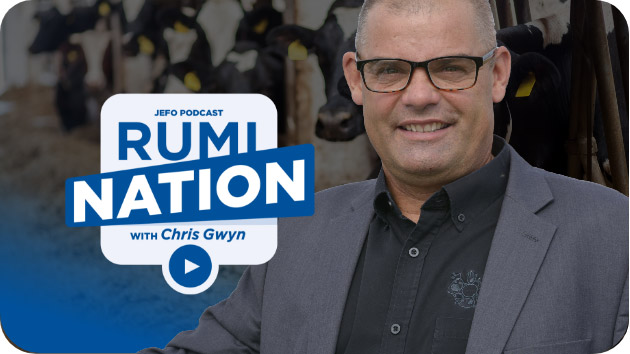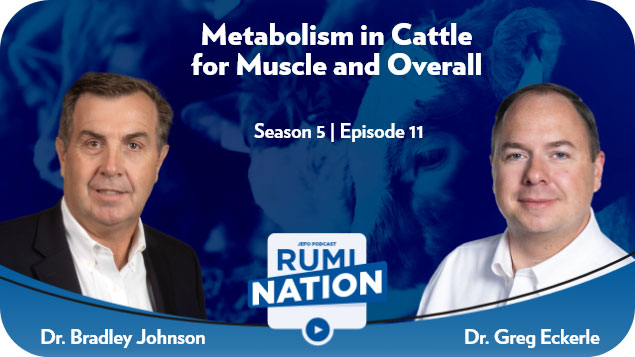RumiNation | S05 : E10
Understanding and Managing Gastrointestinal Tract Health in Cattle
Brought to you by Jefo Nutrition
Share now!
Did you enjoy this episode?
Share now!
Understanding and Managing Gastrointestinal Tract Health in Cattle
In this episode, Dr. Greg Eckerle welcomes Dr. Greg Penner, an expert in cattle nutrition and the regulation of gastrointestinal function in ruminants from the University of Saskatchewan.
Our guest - Dr. Greg Penner
Dr. Greg Penner is a professor in the Department of Animal and Poultry Science and holds a Centennial Enhancement Chair in Ruminant Nutritional Physiology at the University of Saskatchewan since 2009. He obtained his Ph.D. from the University of Alberta in 2009. Dr. Penner’s research focuses on forage utilization, beef and dairy cattle nutrition, and regulation of gastrointestinal function in ruminants.

Timestamps & Summary
Dr. Greg Eckerle (01:24)
Do we normally call that intestinal acidosis outside of the agricultural university complex?
Dr. Greg Penner
I think probably the most common term that’s used is hindgut acidosis rather than intestinal acidosis. And it probably makes sense given where we think most of that fermentation activity would occur and where the primary reduction in pH would be localized.
Dr. Greg Eckerle (02:02)
What can we do with the hindgut intestinal acidosis? And how is that having an impact?
Dr. Greg Penner
First of all, one of the things we need to recognize is rumen acidosis and hindgut acidosis often occur simultaneously. And in fact, we probably should reclassify ruminal acidosis to lumenal, so that it encompasses a broader area of the gastrointestinal tract. You’re right, from a challenge or mitigating response, it’s not easy to deliver compounds that are going to be released to buffer in the large intestine. So, we’re really needing to focus more on strategies that promote ruminal digestion efficiently while minimizing or managing the risk of fermentable materials that reach the large intestine.
Dr. Greg Eckerle (05:19)
Is there any sort of mitigation practices that we could utilize to help keep that intestinal junction and intestinal villi healthy?
Dr. Greg Penner
Certainly, our data as well as others have shown that if the pH is too low for too long, again, we don’t have good thresholds characterized for the hindgut, but we do see a leaky gut, or at least increased permeability of the gut. Our work has been able to show that both outside of the animal using ex vivo conditions and also inside the animal using in vivo markers, we actually see greater permeability responses in post-ruminal regions rather than the ruminal region. […]
Dr. Greg Eckerle (08:27)
What can we utilize and look at when we see animals undergoing a medicinal acid challenge?
Dr. Greg Penner
I think it’s really hard to differentiate ruminal acidosis and hindgut acidosis. And as I mentioned earlier, they often occur simultaneously. I think in many cases, we’ve looked at indicators of hindgut acidosis as evidence for ruminal acidosis. And so we’ve probably been looking at it backward. […]
Dr. Greg Eckerle (11:56)
Do we see an alteration in more pathogenic bacteria or harmful bacteria to the animal which could lead to increased ailments, transition of other things that enterotoxins, and things like that?
Dr. Greg Penner
There was some nice work done by Dr. Kees Plaizier at the University of Manitoba where they did some grain versus alfalfa induction protocols for ruminal acidosis. And fortunately, they have both ruminal microbial changes. And in some of those studies, they also have hindgut microbial changes. And if I recall right, I believe E. Coli abundance, I think they stopped at a genre level, but E. Coli abundance was increased. And so certainly we get concerned about E. Coli from a potential contaminant of meat or meat products and not something we want to increase concentration of, recognizing not all E. Coli will be harmful or truly pathogenic. […]
Dr. Greg Eckerle (13:48)
When we look at the terminal carcass evaluation of these animals, do we see an increase in liver abscess scores from Fusobacteriumthat may cross this damaged intestinal?
Dr. Greg Penner
That’s a great question, and that’s the hypothesis we have. But unfortunately, I have not seen any data that confirms whether Fusobacterium is crossing the rumen, crossing regions of the intestine, or both. […]
Dr. Greg Eckerle (16:15)
Are there certain production periods for either both beef and dairy that we need to be paying more attention to with those management practices to help reduce those risks?
Dr. Greg Penner
Let’s start on the dairy side. I think probably the greatest risk factor is early in the transition phase. And the reason I say that is there’s a number of changes that have likely occurred during that time. […]
In terms of feedlot cattle, I think any factor, again, that leads to a reduction in the feed intake, even a transient reduction, probably increases risk for rumen and hindgut acidosis. So, these could be things like respiratory disease, it could be heat stress events, they could be transportation events. […]
Dr. Greg Eckerle (21:52)
What would be three of the main take-home messages that we have for nutritionists, veterinarians, and producers when we want to help mitigate or strategize systems on farms?
Dr. Greg Penner
I think the first one is […] that what happens in the rumen influences the more distal parts of the gastrointestinal tract. […]
The second one is when we look at the responsiveness of the intestinal regions, they’re probably regions that are more prone to leakiness. […]
The third one goes back to good standard practices, and I think this will never be eliminated from the core tasks or core skills of a nutritionist bunk calling. […]







